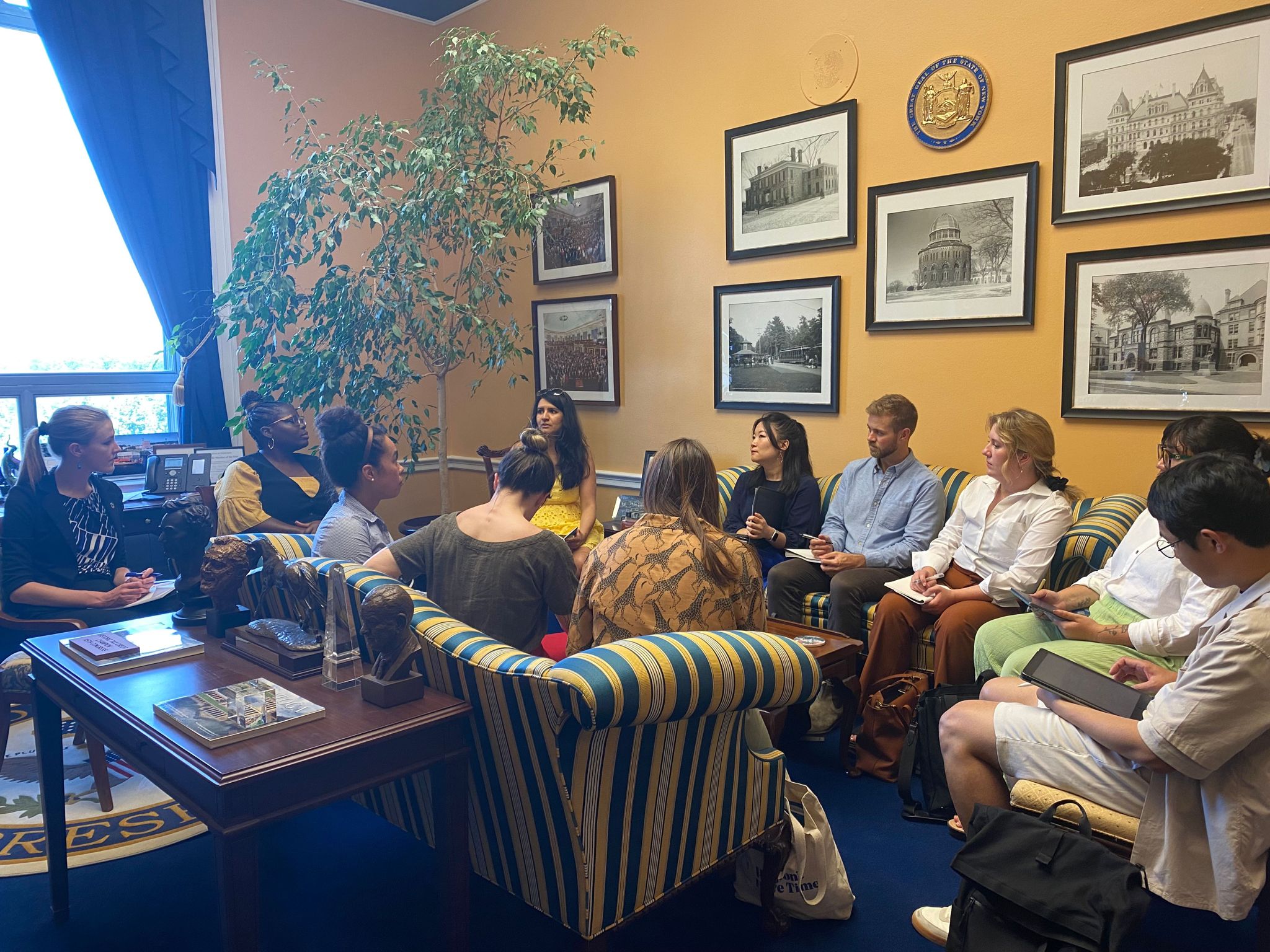Authored by Jake Ferrell, Carbon Justice Fellow at the National Wildlife Federation
Set up in their on-site warehouse, company leadership gathered perhaps fifty people, myself included, around a large presentation screen to show what went into building and deploying their climate-saving direct air capture (DAC) technology. They presented their aims, a polished pitch: DAC modules widely deployed with low-costs, at commercial scale, and located in the desert somewhere so it wouldn’t bother anyone. A hand shot up – had they considered the environmental justice (EJ) dimensions of their projects? Doubts were voiced that projects would, in reality, be located so far away from communities, let alone sensitive wildlife and ecosystems. The question was shouted, barely audible in the cacophonous mechanical environment. “We didn’t think about that yet,” company leadership replied. “We’ve been focused on the engineering of building a DAC plant.”

The Carbon Removal Justice Fellows meet with members of the Senate Budget Committee on Capitol Hill. Photo credit: Jake Ferrell
The Carbon Removal Justice Fellowship was created to center equity and justice considerations in carbon removal policy. National Wildlife Federation partnered with American University’s Institute for Carbon Removal Law & Policy to co-run the program. The fellowship’s creators saw an opportunity to gather a diverse group of talented people to meet at the intersections of environmental justice and carbon removal in order to facilitate important conversations on how to avoid this industry becoming another harmful iteration of the status quo. The fellowship’s inaugural cohort was made up of folks working in environmental law, community advocacy for frontline communities, clean water, decarbonizing heavy industry, carbon removal social science, and more.
What is Carbon Dioxide Removal?
Carbon dioxide removal (CDR) is a strategy whereby CO2 is removed directly from the ambient air and sequestered in a form that prevents it from re-entering the atmosphere. CDR addresses the climate crisis by targeting excess atmospheric CO2, a result of societal industrialization. Examples of CDR range from natural solutions like reforestation to more technological processes like DAC.

Fellows meet with representative offices on Capitol Hill. Photo credit: Jake Ferrell
Centering Environmental Justice in Carbon Dioxide Removal
The potential benefits of CDR include the prospect of addressing legacy emissions, and the ability to make room for self-determined development in places that might require steel, concrete, or other emissions-generating industries during the energy transition. The growing CDR industry, however, still has a series of challenges to grapple with regarding its energy demands, water use, climate-relevant scalability, economic cost, and transportation of CO2 from capture to sequestration sites. Additionally, this sector cannot afford to ignore the country’s long-standing legacy of racist pollution, siting injustices, and undelivered promises. Projects and communities are always inextricably intertwined, both economically and environmentally, so projects need to incorporate environmental justice considerations such as self-determination, informed consent, and mutual respect from the early planning stages of a project.
But environmental justice is more than listed principles – it is an active and variable movement with many facets, so it is vital that as the carbon removal sector experiences rapid growth, justice, conservation, and labor voices claim a seat at the table to be heard. Thus far, many active EJ organizations have been understandably critical of CDR conversations that do not appear to take seriously the social implications and historical legacies of adding more industrial projects in their communities. There is a risk that carbon removal provides an excuse for mitigation deterrence, or the postponing of society’s necessary transition away from fossil fuels. Many in the Carbon Removal Justice Fellowship carried forward this skeptical EJ ethos into conversations in the CDR space.
Urging the Industry to Consider its Impacts
The eleven Fellows managed to visit Washington, D.C., New York, NY, Laramie, WY, and Denver, CO within a packed 15 days in July. We talked to folks at organizations like the BlueGreen Alliance, Carbon180, Carbon Business Council, US Department of Energy, WE ACT for Environmental Justice, and World Resources Institute to name a few. The Fellows also spent two days engaging in CDR conversations on Capitol Hill. In my view, our purpose – the red thread guiding us through our manifold meetings – was to hold space, to parse through some of the complex issues at the intersections of EJ and CDR, and to challenge existing perceptions. In this last aspect we were especially successful, and success in this instance often meant tension and uncomfortable exchanges. But tension is often necessary for progress, and many participants across the program appreciated our candor.
Some of the Fellows’ recurring questions from the duration of the program include: What does it mean to center environmental justice in relation to carbon removal? What does it look like for a project to get enthusiastic consent from a community? How are a project’s community benefits determined, and who gets to make those decisions? What does an A+ on a project’s environmental justice and community benefits scorecard look like? How do we move from well-intentioned plans to legally enforceable agreements? Who is accountable to whom, and where does the buck stop?
While historic policy related to carbon removal has been passed and big announcements like the $1.2 billion dollars for DOE’s DAC Hubs continue to roll out, the Carbon Removal Justice Fellows will continue to wrestle with these questions and others in the weeks and months to come. Those two weeks in the July heat mark the beginning of our ongoing engagement with carbon removal and environmental justice.

Photo credit: Jake Ferrell
Such an impactful group could not have come together without Dr. Simone H. Stewart and Shannon Heyck-Williams at the National Wildlife Federation, and Dr. Simon Nicholson and Jenn Brown at the Institute for Carbon Removal Law and Policy at American University, most of whom participated alongside the cohort during the fellowship.
